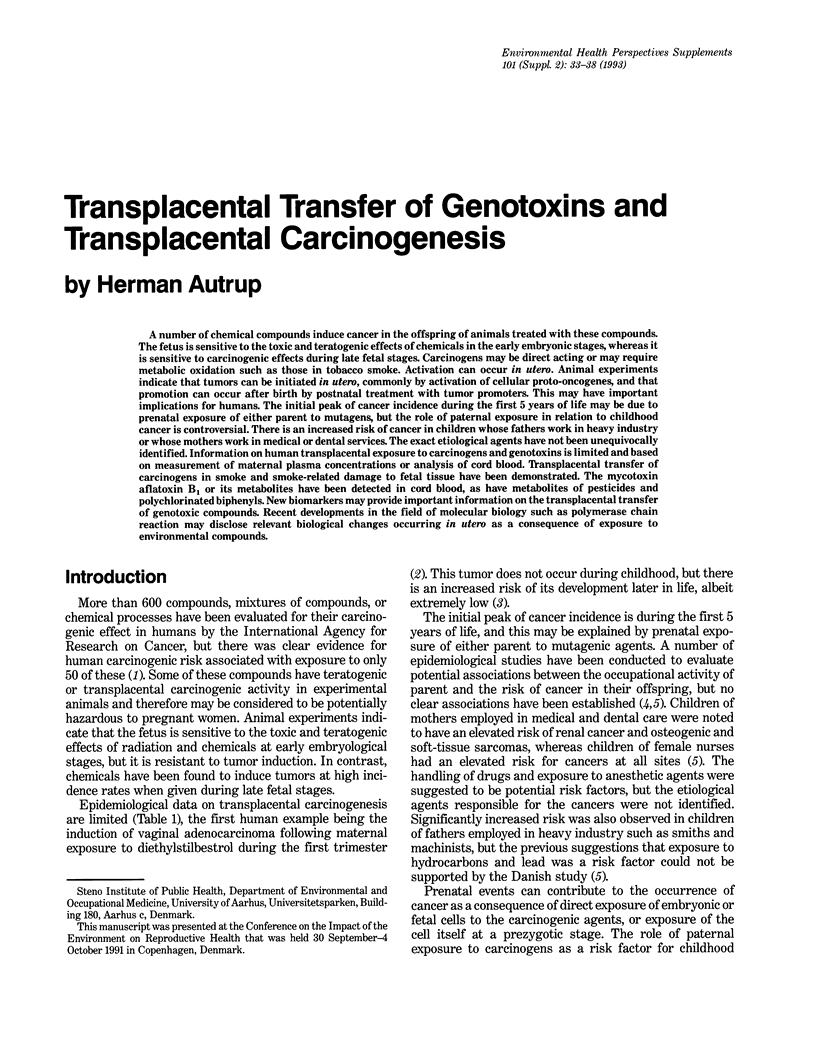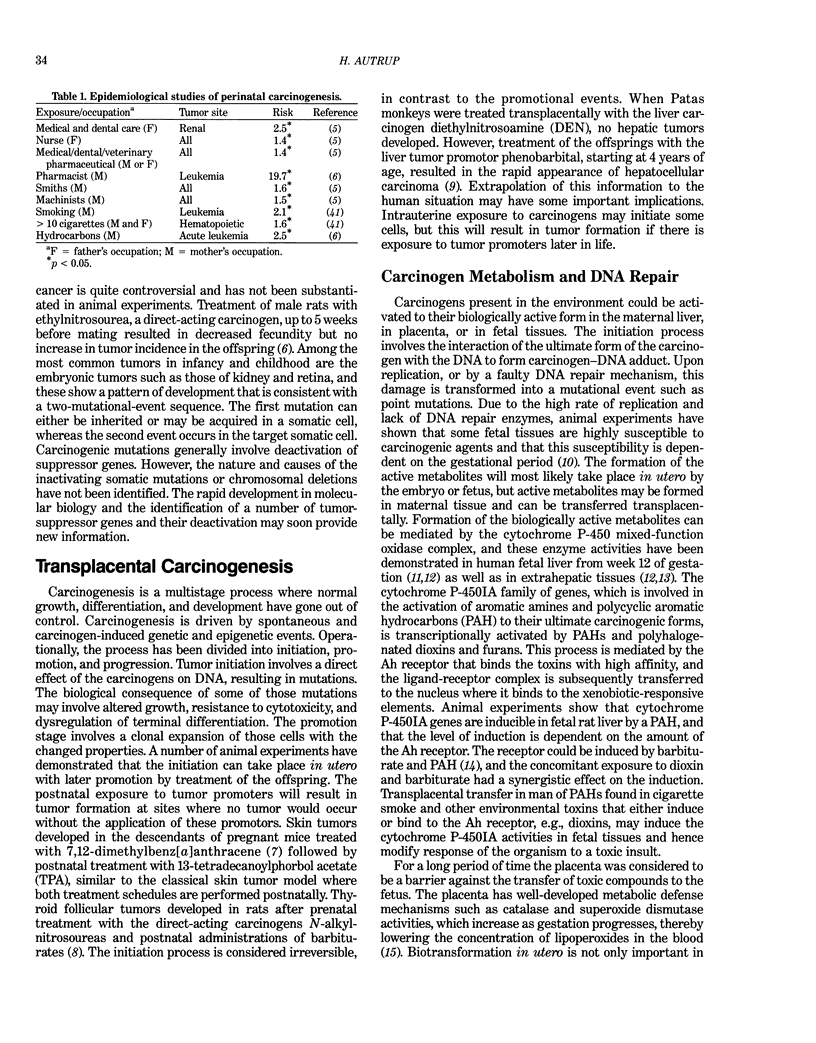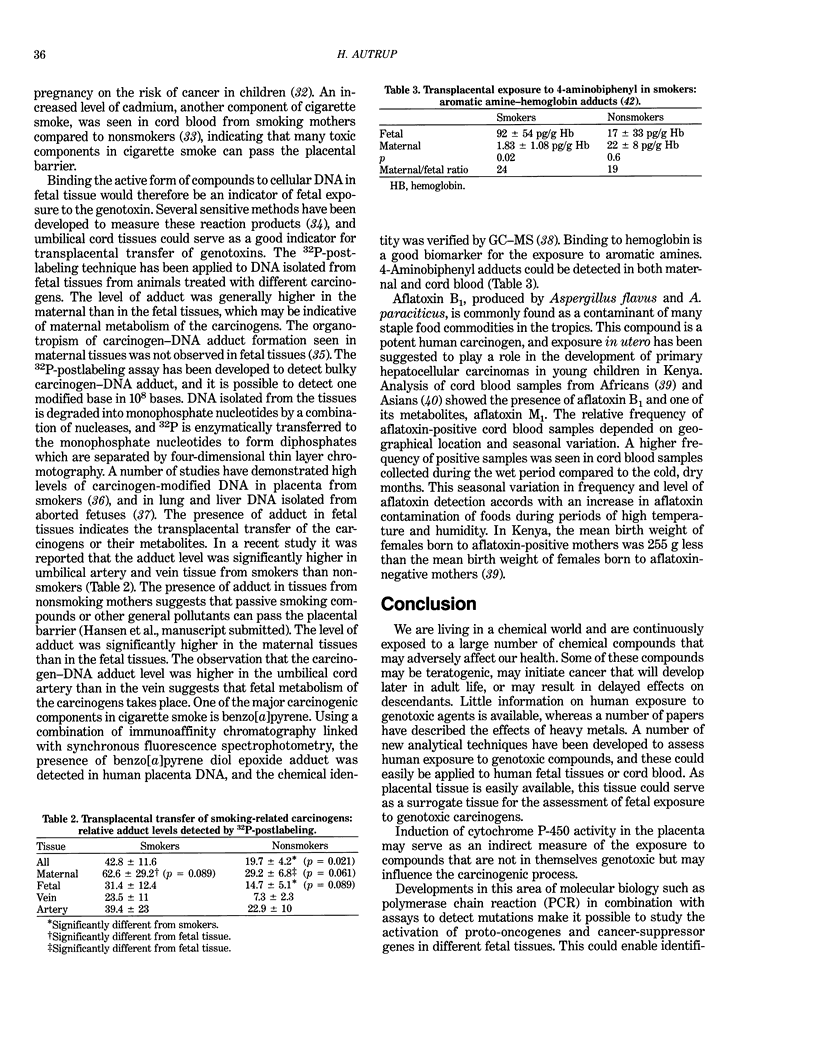Abstract
A number of chemical compounds induce cancer in the offspring of animals treated with these compounds. The fetus is sensitive to the toxic and teratogenic effects of chemicals in the early embryonic stages, whereas it is sensitive to carcinogenic effects during late fetal stages. Carcinogens may be direct acting or may require metabolic oxidation such as those in tobacco smoke. Activation can occur in utero. Animal experiments indicate that tumors can be initiated in utero, commonly by activation of cellular proto-oncogenes, and that promotion can occur after birth by postnatal treatment with tumor promoters. This may have important implications for humans. The initial peak of cancer incidence during the first 5 years of life may be due to prenatal exposure of either parent to mutagens, but the role of paternal exposure in relation to childhood cancer is controversial. There is an increased risk of cancer in children whose fathers work in heavy industry or whose mothers work in medical or dental services. The exact etiological agents have not been unequivocally identified. Information on human transplacental exposure to carcinogens and genotoxins is limited and based on measurement of maternal plasma concentrations or analysis of cord blood. Transplacental transfer of carcinogens in smoke and smoke-related damage to fetal tissue have been demonstrated. The mycotoxin aflatoxin B1 or its metabolites have been detected in cord blood, as have metabolites of pesticides and polychlorinated biphenyls. New biomarkers may provide important information on the transplacental transfer of genotoxic compounds.(ABSTRACT TRUNCATED AT 250 WORDS)
Full text
PDF





Selected References
These references are in PubMed. This may not be the complete list of references from this article.
- Akintonwa A., Gbajumo S. A., Mabadeje A. F. Placental and milk transfer of chloroquine in humans. Ther Drug Monit. 1988;10(2):147–149. doi: 10.1097/00007691-198802000-00004. [DOI] [PubMed] [Google Scholar]
- Aune T., Haugen A., Dybing E. Metabolism and mutagenicity of aromatic amines by human fetal liver. Arch Toxicol. 1985 Jun;57(2):136–138. doi: 10.1007/BF00343124. [DOI] [PubMed] [Google Scholar]
- Autrup H., Harris C. C., Wu S. M., Bao L. Y., Pei X. F., Lu S., Sun T. T., Hsia C. C. Activation of chemical carcinogens by cultured human fetal liver, esophagus and stomach. Chem Biol Interact. 1984 Jun;50(1):15–25. doi: 10.1016/0009-2797(84)90128-5. [DOI] [PubMed] [Google Scholar]
- Autrup H. Human exposure to genotoxic carcinogens: methods and their limitations. J Cancer Res Clin Oncol. 1991;117(1):6–12. doi: 10.1007/BF01613189. [DOI] [PubMed] [Google Scholar]
- Blanck A., Rane A., Toftgård R., Gustafsson J. A. Biotransformation of benzo[a]pyrene and 7-ethoxyresorufin and heme-staining proteins in microsomes from human fetal liver and placenta. Biochem Pharmacol. 1983 May 15;32(10):1547–1552. doi: 10.1016/0006-2952(83)90325-8. [DOI] [PubMed] [Google Scholar]
- Burrows D. A., O'Neil T. J., Sorrells T. L. Successful twin pregnancy after renal transplant maintained on cyclosporine A immunosuppression. Obstet Gynecol. 1988 Sep;72(3 Pt 2):459–461. [PubMed] [Google Scholar]
- Coghlin J., Gann P. H., Hammond S. K., Skipper P. L., Taghizadeh K., Paul M., Tannenbaum S. R. 4-Aminobiphenyl hemoglobin adducts in fetuses exposed to the tobacco smoke carcinogen in utero. J Natl Cancer Inst. 1991 Feb 20;83(4):274–280. doi: 10.1093/jnci/83.4.274. [DOI] [PubMed] [Google Scholar]
- Denning D. W., Allen R., Wilkinson A. P., Morgan M. R. Transplacental transfer of aflatoxin in humans. Carcinogenesis. 1990 Jun;11(6):1033–1035. doi: 10.1093/carcin/11.6.1033. [DOI] [PubMed] [Google Scholar]
- Diwan B. A., Ohshima M., Rice J. M. Effects of postnatal administration of tumour-promoting barbiturates on the development of tumours initiated by prenatal exposure of fetal rats and mice to N-alkylnitrosoureas. IARC Sci Publ. 1989;(96):75–80. [PubMed] [Google Scholar]
- Everson R. B., Randerath E., Santella R. M., Cefalo R. C., Avitts T. A., Randerath K. Detection of smoking-related covalent DNA adducts in human placenta. Science. 1986 Jan 3;231(4733):54–57. doi: 10.1126/science.3941892. [DOI] [PubMed] [Google Scholar]
- Hatch M. C., Warburton D., Santella R. M. Polycyclic aromatic hydrocarbon-DNA adducts in spontaneously aborted fetal tissue. Carcinogenesis. 1990 Sep;11(9):1673–1675. doi: 10.1093/carcin/11.9.1673. [DOI] [PubMed] [Google Scholar]
- Herbst A. L., Kurman R. J., Scully R. E., Poskanzer D. C. Clear-cell adenocarcinoma of the genital tract in young females. Registry report. N Engl J Med. 1972 Dec 21;287(25):1259–1264. doi: 10.1056/NEJM197212212872501. [DOI] [PubMed] [Google Scholar]
- Holroyd K. J., Tamura N., Banks T., Kirby M., Okayama H., Crystal R. G. Limited diversity of gamma delta T-cell antigen receptor junctional region sequences in individuals with sarcoidosis compared to broad diversity in normal subjects. Trans Assoc Am Physicians. 1990;103:102–111. [PubMed] [Google Scholar]
- Juchau M. R. Bioactivation in chemical teratogenesis. Annu Rev Pharmacol Toxicol. 1989;29:165–187. doi: 10.1146/annurev.pa.29.040189.001121. [DOI] [PubMed] [Google Scholar]
- Karube T., Odagiri Y., Takemoto K., Watanabe S. Analyses of transplacentally induced sister chromatid exchanges and micronuclei in mouse fetal liver cells following maternal exposure to cigarette smoke. Cancer Res. 1989 Jul 1;49(13):3550–3552. [PubMed] [Google Scholar]
- Likhachev A., Anisimov V., Loktionov A., Zabezhinski M., Napalkov N., Tomatis L. Increased tumour incidence and skin tumour promotion in two generations of descendants of 7,12-dimethylbenz[a]anthracene-treated pregnant mice. IARC Sci Publ. 1989;(96):81–92. [PubMed] [Google Scholar]
- Loktionov A., Hollstein M., Martel N., Galendo D., Cabral J. R., Tomatis L., Yamasaki H. Tissue-specific activating mutations of Ha- and Ki-ras oncogenes in skin, lung, and liver tumors induced in mice following transplacental exposure to DMBA. Mol Carcinog. 1990;3(3):134–140. doi: 10.1002/mc.2940030306. [DOI] [PubMed] [Google Scholar]
- Manchester D. K., Weston A., Choi J. S., Trivers G. E., Fennessey P. V., Quintana E., Farmer P. B., Mann D. L., Harris C. C. Detection of benzo[a]pyrene diol epoxide-DNA adducts in human placenta. Proc Natl Acad Sci U S A. 1988 Dec;85(23):9243–9247. doi: 10.1073/pnas.85.23.9243. [DOI] [PMC free article] [PubMed] [Google Scholar]
- Marie S., Anderson A., Cresteil T. Transplacental induction of cytochromes P-450IA1 and P-450IA2 by polycyclic aromatic carcinogens: TCDD-binding protein level as the rate-limiting step. Carcinogenesis. 1988 Nov;9(11):2059–2063. doi: 10.1093/carcin/9.11.2059. [DOI] [PubMed] [Google Scholar]
- McGinniss M. J., Falta M. T., Sullivan L. M., Albertini R. J. In vivo hprt mutant frequencies in T-cells of normal human newborns. Mutat Res. 1990 Feb;240(2):117–126. doi: 10.1016/0165-1218(90)90015-t. [DOI] [PubMed] [Google Scholar]
- Müller R., Rajewsky M. F. Elimination of O6-ethylguanine from the DNA of brain, liver, and other rat tissues exposed to ethylnitrosourea at different stages of prenatal development. Cancer Res. 1983 Jun;43(6):2897–2904. [PubMed] [Google Scholar]
- O'Brien P. C., Noller K. L., Robboy S. J., Barnes A. B., Kaufman R. H., Tilley B. C., Townsend D. E. Vaginal epithelial changes in young women enrolled in the National Cooperative Diethylstilbestrol Adenosis (DESAD) project. Obstet Gynecol. 1979 Mar;53(3):300–308. [PubMed] [Google Scholar]
- Oravec C. T., Samuel M. J., D'Ambrosio S. M. Metabolism of 7,12-dimethylbenz(a)anthracene and its DNA adduct formation in human fetal kidney and intestinal cells in culture. Drug Metab Dispos. 1985 Jan-Feb;13(1):76–80. [PubMed] [Google Scholar]
- Pacifici G. M., Colizzi C., Giuliani L., Rane A. Cytosolic epoxide hydrolase in fetal and adult human liver. Arch Toxicol. 1983 Dec;54(4):331–341. doi: 10.1007/BF01234486. [DOI] [PubMed] [Google Scholar]
- Pasanen M., Pelkonen O. Human placental xenobiotic and steroid biotransformations catalyzed by cytochrome P450, epoxide hydrolase, and glutathione S-transferase activities and their relationships to maternal cigarette smoking. Drug Metab Rev. 1989;21(3):427–461. doi: 10.3109/03602538909030305. [DOI] [PubMed] [Google Scholar]
- Pershagen G. Childhood cancer and malignancies other than lung cancer related to passive smoking. Mutat Res. 1989 Feb;222(2):129–135. doi: 10.1016/0165-1218(89)90026-8. [DOI] [PubMed] [Google Scholar]
- Randerath K., Liehr J. G., Gladek A., Randerath E. Use of the 32P-postlabelling assay to study transplacental carcinogens and transplacental carcinogenesis. IARC Sci Publ. 1989;(96):189–205. [PubMed] [Google Scholar]
- Savitz D. A., Chen J. H. Parental occupation and childhood cancer: review of epidemiologic studies. Environ Health Perspect. 1990 Aug;88:325–337. doi: 10.1289/ehp.9088325. [DOI] [PMC free article] [PubMed] [Google Scholar]
- Saxena M. C., Siddiqui M. K., Agarwal V., Kuuty D. A comparison of organochlorine insecticide contents in specimens of maternal blood, placenta, and umbilical-cord blood from stillborn and live-born cases. J Toxicol Environ Health. 1983 Jan;11(1):71–79. doi: 10.1080/15287398309530321. [DOI] [PubMed] [Google Scholar]
- Sikorski R., Radomański T., Paszkowski T., Skoda J. Smoking during pregnancy and the perinatal cadmium burden. J Perinat Med. 1988;16(3):225–231. doi: 10.1515/jpme.1988.16.3.225. [DOI] [PubMed] [Google Scholar]
- Skaare J. U., Tuveng J. M., Sande H. A. Organochlorine pesticides and polychlorinated biphenyls in maternal adipose tissue, blood, milk, and cord blood from mothers and their infants living in Norway. Arch Environ Contam Toxicol. 1988 Jan;17(1):55–63. doi: 10.1007/BF01055154. [DOI] [PubMed] [Google Scholar]
- Sukumar S., Barbacid M. Specific patterns of oncogene activation in transplacentally induced tumors. Proc Natl Acad Sci U S A. 1990 Jan;87(2):718–722. doi: 10.1073/pnas.87.2.718. [DOI] [PMC free article] [PubMed] [Google Scholar]
- Takehara Y., Yoshioka T., Sasaki J. Changes in the levels of lipoperoxide and antioxidant factors in human placenta during gestation. Acta Med Okayama. 1990 Apr;44(2):103–111. doi: 10.18926/AMO/30438. [DOI] [PubMed] [Google Scholar]
- Tomatis L., Turusov V. S., Cardis E., Cabral J. P. Tumour incidence in the progeny of male rats exposed to ethylnitrosourea before mating. Mutat Res. 1990 Apr;229(2):231–237. doi: 10.1016/0027-5107(90)90096-m. [DOI] [PubMed] [Google Scholar]
- Wong T. K., Domin B. A., Bent P. E., Blanton T. E., Anderson M. W., Philpot R. M. Correlation of placental microsomal activities with protein detected by antibodies to rabbit cytochrome P-450 isozyme 6 in preparations from humans exposed to polychlorinated biphenyls, quaterphenyls, and dibenzofurans. Cancer Res. 1986 Feb;46(2):999–1004. [PubMed] [Google Scholar]


